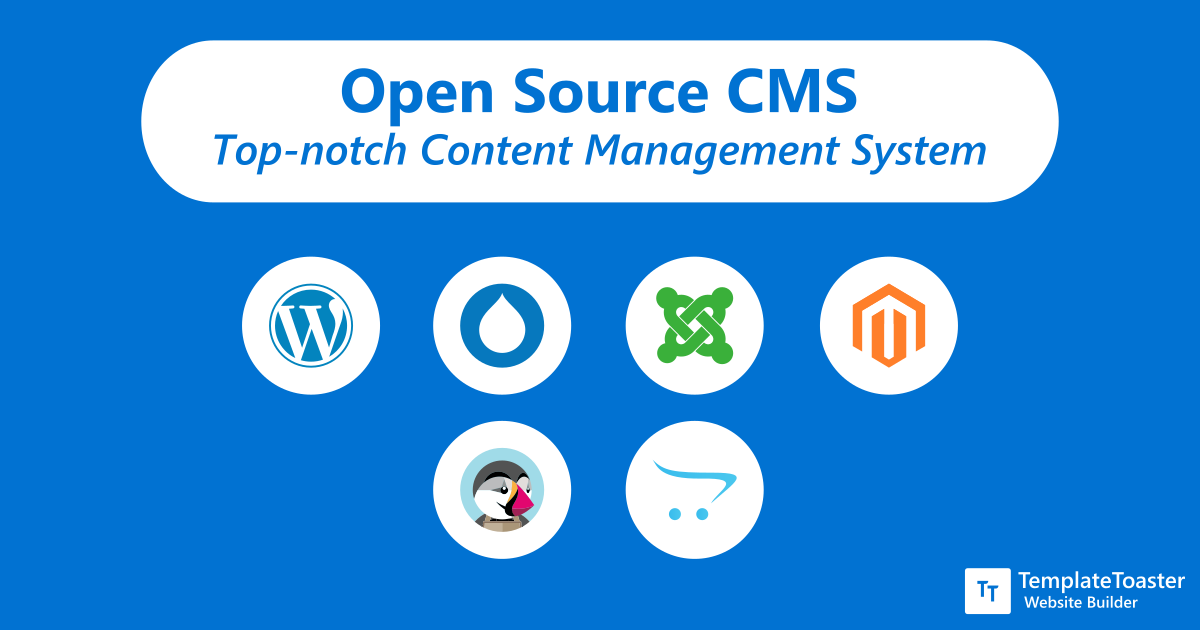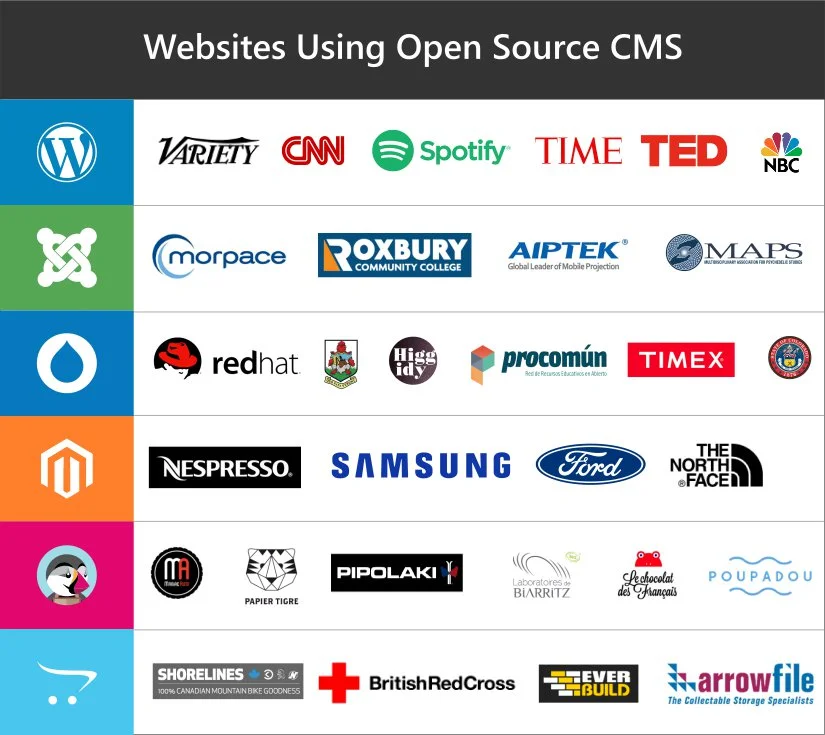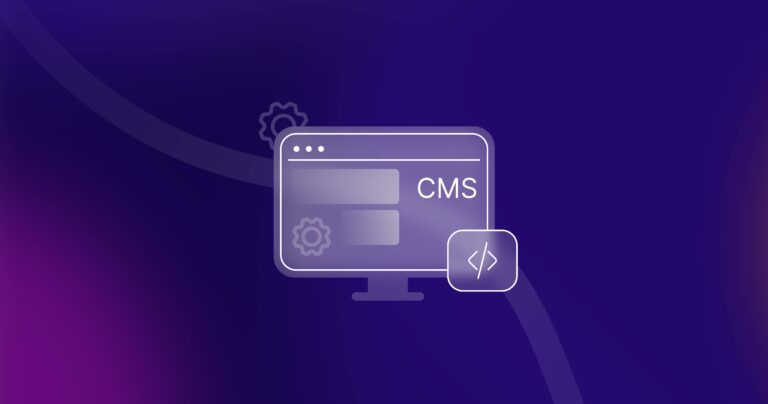Best Open Source CMS Platforms: 2024 Ultimate Guide
The best open-source CMS options include WordPress, Joomla, and Drupal. Each platform offers unique features and flexibility for different website needs.
Open-source content management systems (CMS) empower users to create and manage websites without high costs. They provide customizable solutions suitable for various projects, from blogs to e-commerce sites. WordPress stands out for its user-friendly interface and extensive plugin ecosystem, making it ideal for beginners and professionals alike.
Joomla offers robust features for more complex websites, while Drupal caters to developers needing advanced customization. Choosing the right CMS depends on your specific needs, technical skills, and the type of content you plan to publish. Exploring these options can help you find the perfect fit for your online presence.
Introduction To Open Source Cms
An Open Source Content Management System (CMS) allows users to create, manage, and modify content easily. These systems are built on transparent software that anyone can use or modify. This approach fosters community collaboration, innovation, and flexibility. The open-source model has gained popularity for its cost-effectiveness and customizable nature.
The Rise Of Open Source Software
Open-source software has become vital in the digital landscape. Many businesses and individuals prefer this model. Here are some reasons for its rapid growth:
- Cost-Effective: No licensing fees required.
- Community Support: Active communities help with issues.
- Customization: Users can modify the source code.
- Security: Transparency leads to better security checks.
Open-source CMS platforms have gained traction due to these advantages. They empower users to build websites tailored to their needs.
Benefits Of Using An Open Source Cms
Choosing an open-source CMS offers many benefits. Here are some key advantages:
| Benefit | Description |
|---|---|
| Flexibility | Users can customize features as needed. |
| Cost Savings | No fees for software; only hosting costs. |
| Ease of Use | User-friendly interfaces make management simple. |
| Active Community | Support from users and developers worldwide. |
Open-source CMS platforms foster creativity. Users can build unique websites. They also receive ongoing updates and improvements.

Credit: www.techjockey.com
Key Features To Look For In A Cms
Choosing the right Content Management System (CMS) is crucial. A good CMS can make managing your website easy. Below are key features to consider.
Ease Of Use
Look for a CMS that is simple to navigate. User-friendly interfaces save time. Here are some important factors:
- Clear dashboard layout
- Intuitive content editing tools
- Easy media management
- Simple publishing process
Try demo versions to check usability. A good CMS should not require extensive training.
Customization And Flexibility
Your CMS should allow for extensive customization. This helps create a unique website. Important aspects include:
- Variety of themes and templates
- Plugin or module support
- Custom coding options
- Responsive design capabilities
Flexibility lets you adapt as your needs grow. Choose a CMS that can evolve with your website.
Security And Support
Security is a top priority. Your CMS should protect against threats. Here are key security features:
- Regular software updates
- Strong user authentication
- SSL support
- Backup options
Also, ensure you have access to support resources. Look for:
- Documentation and guides
- Community forums
- Customer support channels
Community And Resources
A robust community is vital for any CMS. A strong user base offers many benefits:
- Shared knowledge and tips
- Third-party plugins and themes
- Regular updates and improvements
Check the community’s size and activity. This can indicate the CMS’s longevity and reliability.
Top Open Source Cms Platforms Of 2024
Open-source CMS platforms are gaining popularity in 2024. They provide flexibility and power to users. Businesses and individuals can create stunning websites easily. This guide highlights the best options available this year.
Evaluating The Leaders
Several platforms stand out as the top choices for users. They offer robust features, strong communities, and constant updates. Here are the leaders in the open-source CMS market:
| CMS Platform | Key Features | Best For |
|---|---|---|
| WordPress | Flexible, thousands of plugins, user-friendly | Blogs, small to large websites |
| Joomla | Advanced user management, multi-language support | Social networks, e-commerce sites |
| Drupal | Highly customizable, strong security features | Complex sites, large organizations |
Emerging Contenders
New platforms are also making waves in the CMS landscape. They offer innovative solutions that cater to specific needs. Here are some emerging contenders:
- Ghost – Focuses on blogging and publishing.
- Grav – Flat-file CMS, perfect for developers.
- October CMS – Simple and modern with a strong community.
Niche And Specialized Platforms
Some CMS platforms serve specific industries or needs. They cater to users looking for specialized features. Here are notable niche platforms:
- Magento – Best for e-commerce solutions.
- TYPO3 – Great for enterprise-level websites.
- SilverStripe – Ideal for custom web applications.
Choosing the right open-source CMS can enhance your online presence. Assess your needs carefully to find the best fit.

Credit: refine.dev
Deep Dive Into WordPress
WordPress is the most popular open-source CMS. It powers over 40% of the web. Many users love its flexibility and ease of use. Let’s explore why it remains a top choice.
Why It Remains Popular
WordPress has a strong community behind it. Here are key reasons for its popularity:
- Ease of Use: Beginners can create websites quickly.
- Customization: Thousands of themes and plugins are available.
- SEO-Friendly: Built-in features help with search engine ranking.
- Regular Updates: Developers frequently release security and feature updates.
- Support Community: Forums and tutorials help users resolve issues.
New Features And Improvements
WordPress continually evolves. Recent updates enhance user experience and functionality.
| Feature | Description |
|---|---|
| Block Editor (Gutenberg) | Intuitive content creation with drag-and-drop functionality. |
| Performance Enhancements | Faster loading times for better user experience. |
| Improved Accessibility | Better tools for users with disabilities. |
| Integrated SEO Tools | Built-in options to optimize content for search engines. |
| Enhanced Security | Regular updates and features protect against threats. |
WordPress continues to lead in the CMS market. Its user-friendly design and robust features attract millions. Exploring its capabilities will help you understand its lasting appeal.
Exploring Drupal’s Robustness
Drupal stands out as a powerful open-source CMS. It is renowned for its flexibility and scalability. Many organizations use it to create complex websites. Let’s dive into the key features that make Drupal so robust.
Complex Sites Made Simple
Building intricate websites is easy with Drupal. It offers various built-in tools to simplify the process. Here are a few reasons why:
- Customization: Tailor your site to meet specific needs.
- Scalability: Grow your site as your audience expands.
- Multi-user Support: Manage roles and permissions easily.
- Multilingual Capability: Create content in multiple languages effortlessly.
Drupal’s strong architecture handles heavy traffic well. It supports complex data structures. Users can manage content with ease. This makes it ideal for:
- Government websites
- Educational institutions
- Large corporations
- Non-profit organizations
Community Initiatives And Modules
The Drupal community is vast and active. Numerous developers contribute to its growth. This leads to a wealth of modules. Modules enhance functionality and features. Here are some popular modules:
| Module Name | Functionality |
|---|---|
| Views | Create custom lists and displays of content. |
| Webform | Build forms and surveys easily. |
| Pathauto | Automatically generate SEO-friendly URLs. |
| Token | Use placeholders for dynamic content. |
Community initiatives drive improvements and updates. Developers can share their knowledge and skills. This collaboration fosters innovation. It ensures Drupal stays relevant and powerful.
In summary, Drupal’s robustness shines in its ability to manage complex sites. Its vibrant community further strengthens its capabilities. Users enjoy endless customization and functionality options.
Joomla’s Place In Today’s Market
Joomla remains a significant player among open-source CMS options. It attracts users with its flexibility and power. Many businesses and developers choose Joomla for their projects. This platform caters to both beginners and advanced users.
Balancing Simplicity And Power
Joomla strikes a unique balance between simplicity and power. This makes it accessible for various users. Here are some key points:
- Intuitive Interface: Easy to navigate for beginners.
- Advanced Features: Supports complex sites with multiple users.
- Customization: Offers themes and templates for unique designs.
Joomla is suitable for:
- Small businesses
- Online portfolios
- Large e-commerce sites
User Experience And Extensions
User experience is crucial in any CMS. Joomla provides a smooth experience through its extensive extensions.
| Extension Type | Purpose |
|---|---|
| Plugins | Add functionality without changing the core. |
| Modules | Display content in various positions. |
| Components | Full-fledged applications within Joomla. |
Users can find thousands of extensions. These enhance the functionality of their sites. From SEO tools to e-commerce solutions, Joomla has it all.
Joomla’s community is active and supportive. Users can access forums and tutorials easily. This support helps beginners overcome challenges quickly.
Emergence Of Modern Cms Platforms
The digital landscape is evolving rapidly. Traditional content management systems (CMS) are transforming. Modern CMS platforms offer flexibility and speed. They empower users to create and manage content effectively.
Headless And Api-driven Cms
Headless CMS separates the backend from the front end. This design allows developers to use any technology for display. It provides more freedom and flexibility.
- Benefits of Headless CMS:
- Decoupled architecture
- Improved performance
- Multi-channel publishing
- Customizable user interfaces
- Popular Headless CMS:
- Contentful
- Strapi
- Ghost
API-driven CMS enhances integration with third-party services. It enables seamless data exchange. This approach improves user experience and site functionality.
Static Site Generators
Static site generators (SSG) create fast websites. They build HTML files directly from templates and content. This reduces server load and increases speed.
| Static Site Generators | Key Features |
|---|---|
| Jekyll | Easy integration with GitHub Pages |
| Hugo | Blazing-fast build times |
| Gatsby | React-based, rich plugin ecosystem |
SSGs are great for developers. They allow complete control over design. Websites built with SSGs are often more secure.
Choosing The Right Cms For Your Needs
Finding the best open-source CMS can be challenging. Each CMS has its strengths. The right choice depends on your specific needs. Assess your goals and features to make a wise decision.
Assessing Your Requirements
Start by identifying your main goals. Consider the following:
- Type of website: blog, e-commerce, portfolio, etc.
- Technical skills: beginner, intermediate, advanced.
- Design needs: templates, customization options.
- Budget: hosting, themes, plugins.
- Scalability: Can it grow with your needs?
List these requirements to create a clear picture. Focus on what matters most to you.
Comparative Analysis Of Cms Options
Here’s a quick comparison of popular open-source CMS options:
| CMS | Best For | Ease of Use | Customization | Community Support |
|---|---|---|---|---|
| WordPress | Blogs & Simple Sites | Very Easy | High | Large Community |
| Joomla | Complex Sites | Moderate | High | Active Community |
| Drupal | Advanced Users | Challenging | Very High | Strong Community |
| Magento | E-commerce | Moderate | High | Active Community |
Consider these factors for each option:
- Check user reviews and testimonials.
- Evaluate the available plugins and themes.
- Think about future updates and security.
- Assess ease of migration if needed.
Make a list of pros and cons for each CMS. This will guide your decision-making process.
Migrating To A New Cms
Switching to a new CMS can feel daunting. Proper planning makes the process smoother. A well-executed migration helps maintain content integrity and user experience.
Planning Your Migration
Effective migration requires careful planning. Follow these steps for a successful transition:
- Identify Goals: Define what you want to achieve.
- Choose the Right CMS: Select a CMS that meets your needs.
- Inventory Current Content: List all existing content.
- Map Content Structure: Organize how content will appear.
- Backup Data: Create a full backup of your current site.
Challenges And Best Practices
Migrating to a new CMS has challenges. Recognizing these can ease the process.
| Challenge | Best Practice |
|---|---|
| Data Loss | Always back up your data before migration. |
| SEO Impact | Set up 301 redirects to preserve SEO rankings. |
| Content Formatting | Test content formatting on the new CMS beforehand. |
| User Training | Provide training for users on the new system. |
| Time Management | Set a realistic timeline for migration. |
Keep these challenges and best practices in mind. They help ensure a smooth transition to your new CMS.
The Future Of Content Management Systems
The future of Content Management Systems (CMS) is bright and exciting. New technologies are reshaping how we create and manage content. Open-source CMS options are evolving rapidly. They offer flexibility, security, and community support. This evolution leads to better user experiences and efficient workflows.
AI and Machine Learning Integration
Artificial Intelligence (AI) and Machine Learning (ML) are game changers for CMS. They automate many tasks, saving time and effort. Here are some key benefits:
- Personalization: AI analyzes user behavior. It helps create tailored content for audiences.
- Content Creation: AI tools can generate articles. They assist in writing and editing processes.
- SEO Optimization: AI can suggest keywords. It improves content visibility on search engines.
Consider these AI-driven CMS features:
| Feature | Description |
|---|---|
| Chatbots | Provide instant support and answer queries. |
| Content Recommendations | Suggest related articles to users. |
| Analytics | Track user engagement and content performance. |
Decentralized And Blockchain Cms
Decentralized systems are changing the game. They use blockchain technology for content management. This leads to increased security and transparency. Here are some benefits:
- Ownership: Users retain full control of their data.
- Security: Content is stored on multiple nodes. This reduces the risk of hacks.
- Transparency: Every change is recorded on the blockchain. This builds trust among users.
Some promising features of decentralized CMS include:
- Smart contracts for automated agreements.
- Peer-to-peer content sharing and collaboration.
- Token-based reward systems for content creators.

Credit: blog.templatetoaster.com
Frequently Asked Questions
What Is An Open Source Cms?
An open-source CMS is a content management system that allows users to create, manage, and modify digital content freely.
Why Choose An Open Source Cms?
Open-source CMS platforms offer flexibility, cost-effectiveness, and a community-driven approach to development and support.
Which Is The Best Open Source Cms?
Popular options include WordPress, Joomla, and Drupal, each offering unique features and functionalities for different needs.
Is WordPress An Open Source Cms?
Yes, WordPress is one of the most widely used open-source CMS platforms, powering millions of websites globally.
How Secure Are Open Source Cms Platforms?
Security varies by platform and usage; regular updates and strong practices enhance security in open-source CMS options. “`
Conclusion
Choosing the right open-source CMS can significantly impact your website’s success. Each platform offers unique features to meet various needs. Whether you prioritize customization, user-friendliness, or support, there’s an option for you. Take the time to explore these choices and find the best fit for your project today.



